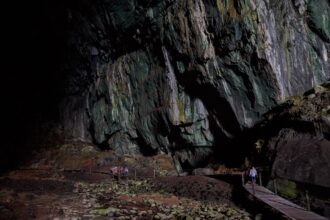Nestled within the verdant hills of Asuka Village, Japan, lies an enigma carved in stone – the colossal Masuda-no-iwafune, or the Rock Ship of Masuda. This monolithic granite structure, an imposing 11 meters long, 8 meters wide, and 4.7 meters high, weighing an estimated 800 tonnes, stands as a silent testament to a forgotten era. Its sheer size and peculiar, boat-like shape immediately ignite curiosity, prompting endless speculation about its purpose and the civilization that painstakingly crafted it.
The Rock Ship is distinguished by its remarkably smooth, flat top surface, punctuated by two large, rectangular depressions. The precision of these indentations and the overall smooth finish of the massive stone suggest advanced carving techniques, especially considering the tools and technology that would have been available at the time of its creation. The sides of the structure slope gently downwards, further contributing to its ship-like appearance, a feature that has inspired its evocative name.
Despite extensive archaeological investigations and scholarly debate, the exact origins and intended function of the Masuda-no-iwafune remain shrouded in mystery. Unlike many other ancient sites, there are no inscriptions or definitive historical records directly associated with its carving. This lack of contextual information has fueled a variety of theories, ranging from the practical to the esoteric.
Some researchers propose that the rock served a utilitarian purpose, perhaps as the base for a large structure, an unfinished tomb for a powerful figure, or even an astronomical observatory. The precise rectangular depressions could have held pillars for a building or sarcophagi. Others suggest a more ritualistic or symbolic significance, linking it to ancient Shinto practices or cosmological beliefs. The ship form might have held symbolic meaning related to journeys, either earthly or spiritual.
The immense scale of the carving and the precision of its features underscore the sophisticated engineering and organizational capabilities of the people who created it. Transporting and shaping such a massive stone would have required significant manpower, planning, and technical skill. The Rock Ship of Masuda, therefore, not only presents a puzzle in terms of its purpose but also offers a glimpse into the advanced capabilities of a civilization that once thrived in the Asuka region, leaving behind this monumental mystery for future generations to ponder.







